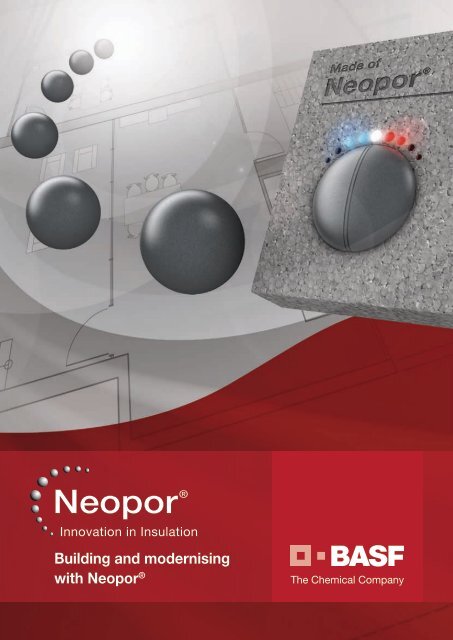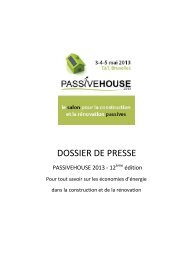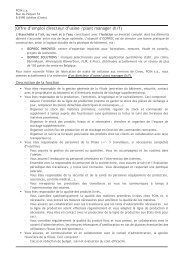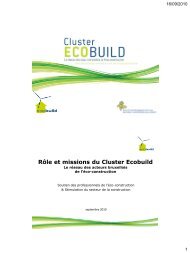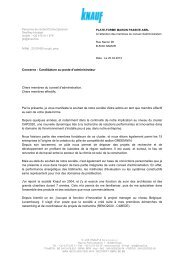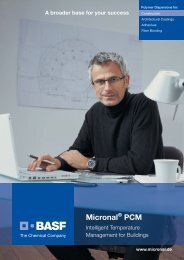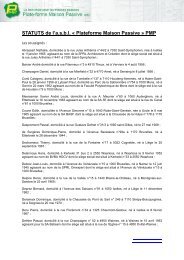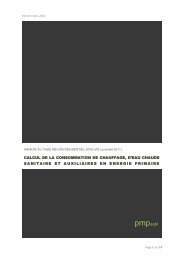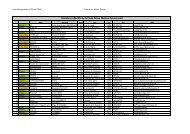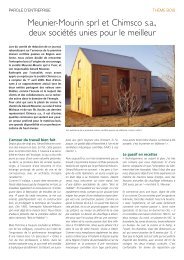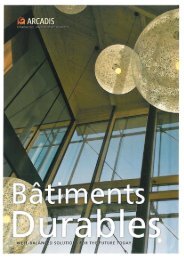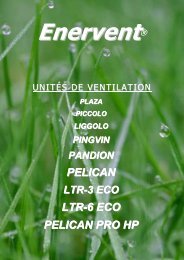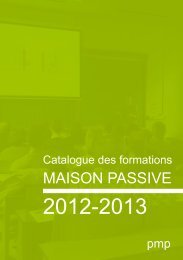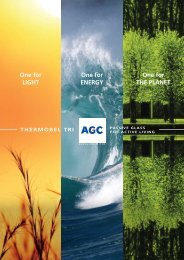Neopor - Plate-forme Maison Passive asbl
Neopor - Plate-forme Maison Passive asbl
Neopor - Plate-forme Maison Passive asbl
You also want an ePaper? Increase the reach of your titles
YUMPU automatically turns print PDFs into web optimized ePapers that Google loves.
Building and modernising<br />
with <strong>Neopor</strong> ®
BUILDING AND MODERNISING WITH NEOPOR ®<br />
INFORMATION FOR ARCHITECTS, ENGINEERS<br />
AND MANUAL WORKERS<br />
CONTENTS<br />
03 > Material – <strong>Neopor</strong> ®<br />
04 > Quality products from BASF<br />
05 > High performance from <strong>Neopor</strong> ®<br />
06 > Thermal insulation and thermal conductivity<br />
07 > Key features of <strong>Neopor</strong> ® insulating materials<br />
08 > Sustainability and efficiency<br />
09 > Ecoefficiency and promotion programmes<br />
10 - 11 > Overview of <strong>Neopor</strong> ® applications<br />
12 > Advantages of <strong>Neopor</strong> ® insulating materials<br />
13 > External insulation ( TICS) – shuttering elements<br />
14 > Insulation behind curtain facades – core insulation<br />
15 > Internal insulation – ceiling insulation (basements)<br />
16 > Over-rafter insulation – inter-rafter insulation<br />
17 > Flat roof insulation – loft insulation<br />
18 - 19 > Practical examples
up to<br />
i n s u l a t e s b e t t e r<br />
SMALL, ROUND, BLACK –<br />
ONE MATERIAL,<br />
MANy APPLICATIONS<br />
NEOpOr ® – <strong>Neopor</strong> ® is composed of small black<br />
beads of polystyrene (EPS) granules containing<br />
a blowing agent, which makes it expandable.<br />
BASF produces this unique material, which is<br />
processed by foam manufacturers, into insulating<br />
materials for a wide range of applications.<br />
THE BLACK BEADS are foamed by converters on<br />
conventional EPS machines and processed to<br />
silver-grey foam blocks and moulded parts with<br />
up to 20 % better insulating performance than<br />
conventional EPS. The blocks are then cut to<br />
boards of different thicknesses.<br />
NEOpOr ® INSULATING MATErIALS offer greater<br />
insulating performance and up to 50 % lower<br />
use of raw materials than conventional EPS,<br />
helping environmental conservation and saving<br />
money. Environmentally-friendly <strong>Neopor</strong> ® insulating<br />
materials do not contain CFCs, HCFCs,<br />
HFCs or other halogenated cell gases. Instead<br />
they contain air as cell gas, which guarantees<br />
the preservation of the thermal conductivity<br />
throughout the life of the construction.<br />
<strong>Neopor</strong> ® insulating materials therefore represent<br />
a modern, environmentally-aware lifestyle. We<br />
call it: “Innovation in Insulation”.<br />
3
1920<br />
QUALITy PRODUCTS FROM BASF – THE BENCHMARK<br />
IN THERMAL INSULATION FOR OVER 50 yEARS<br />
STYrOpOr ® – Behind this name lies a success<br />
story that is everyone’s goal. BASF discovered a<br />
classic over 50 years ago in expandable polystyrene<br />
(EPS). Under the tradename Styropor ® , EPS<br />
is now the solution for efficient insulation and<br />
safe packaging worldwide.<br />
WITH NEOpOr ® , BASF has taken the classic<br />
Styropor ® a step further. This new material<br />
for modern insulating materials is foamed just<br />
like Styropor ® and processed to boards and<br />
moulded parts.<br />
1930<br />
Patent for the polymerization of<br />
monostyrene<br />
1925 1930 1940 1950 1960 1970 1980 1990 2000 2005<br />
1951 Styropor ®<br />
Patent for expandable<br />
polystyrene (EPS, Styropor ® )<br />
4 NEOpOr ® > QUALITY prODUCTS FrOM BASF<br />
THE VITAL DIFFErENCE can be seen with the naked<br />
eye in the silver-grey colour. In <strong>Neopor</strong> ® , graphite<br />
is added to the material, absorbing and reflecting<br />
heat radiation and improving the insulating performance<br />
of EPS by up to 20 %.<br />
prODUCTS MADE FrOM THE MATErIAL NEOpOr ® from<br />
BASF are an economic investment in the future<br />
and add to the value of a property.<br />
1995 <strong>Neopor</strong> ®<br />
Patent on <strong>Neopor</strong> ®
NEOPOR ® – INSULATING MATERIALS WITH A PERFOR-<br />
MANCE PLUS – UP TO 20 % MORE PERFORMANCE<br />
WITH THE SAME BOARD THICKNESS<br />
The special product properties mean that insulating<br />
boards made of this material provide up to<br />
twenty percent more performance than conventional<br />
EPS, due to the fine graphite particles in<br />
<strong>Neopor</strong> ® that act as infrared absorbers or reflectors.<br />
Builders and planners can make use of this<br />
advantage of <strong>Neopor</strong> ® . Using <strong>Neopor</strong> ® insulating<br />
boards, they can achieve a much higher insulating<br />
performance and even lower energy consumption.<br />
<strong>Neopor</strong> ® insulating materials are a winner due to<br />
their higher insulating performance, compared<br />
with conventional EPS.<br />
up to<br />
i n s u l a t e s b e t t e r<br />
THEY ALSO OFFEr OTHEr MAJOr<br />
ADVANTAGES:<br />
Water-repellent<br />
Low moisture absorption<br />
Diffusion-open<br />
Sturdy and dimensionally stable<br />
environmentally-friendly due to high<br />
ecoefficiency<br />
Ageing- and rot-proof<br />
Greater ease of handling due to weight<br />
advantage<br />
Dust-free and easy to lay<br />
Weather-resistant construction<br />
Does not cause skin irritation<br />
5
THERMAL INSULATION IS QUALITy OF LIFE –<br />
WITH NEOPOR ® yOU ARE INVESTING IN A PERCEPTIBLy<br />
IMPROVED LIVING ENVIRONMENT<br />
External components that are not, or not sufficiently,<br />
insulated radiate heat, resulting in a<br />
noticeable, unhealthy draught in the living area.<br />
Poorly insulated components or components<br />
that are not insulated at all are often damp because<br />
condensation forms on the inside, if the<br />
temperature in the component falls and diffus-<br />
ing atmospheric moisture comes into contact<br />
THErMAL INSULATION<br />
SIGNIFICANT ADVANTAGES FOr BUILDING prACTICE<br />
The excellent effect of <strong>Neopor</strong> ® insulating materials<br />
offers architects, engineers, manual workers<br />
and builders significant advantages in building<br />
practice. The <strong>Neopor</strong> ® infrared absorbers or<br />
reflectors considerably reduce thermal conductivity,<br />
and the permeability of the material with<br />
regard to heat is lower than in normal insulating<br />
boards.<br />
Infrared absorbers and reflectors largely prevent heat loss<br />
caused by radiation.<br />
6 NEOpOr ® > THErMAL INSULATION IS QUALITY OF LIFE<br />
with colder layers. This condensation can cause<br />
mould and rot, and affects the health and wellbeing<br />
of the residents. It also causes significant<br />
damage to the building. Professionally installed<br />
<strong>Neopor</strong> ® insulating materials sustainably prevent<br />
these effects, providing a healthy environment in<br />
new builds and in the housing stock, and saving<br />
energy. And the building retains its value.<br />
THErMAL CONDUCTIVITY<br />
OpTIMISED INSULATING pErFOrMANCE<br />
Vastly improved insulating effects can be<br />
achieved with <strong>Neopor</strong> ® , particularly with very<br />
low bulk densities. The diagram shows that<br />
<strong>Neopor</strong> ® insulating materials with a bulk den-<br />
si ty of 15 kg /m 3 , for example, achieve a thermal<br />
conductivity of 0.032 W/(m ∙ K). In normal EPS<br />
with the same bulk density, the thermal con-<br />
ductivity is 0.037 W/(m ∙ K).<br />
Thermal conductivity ��[W/m · K]<br />
0.045<br />
0.040<br />
0.037<br />
0.035<br />
0.032<br />
0.030<br />
0.025<br />
5<br />
EPS<br />
<strong>Neopor</strong> ®<br />
10 15 20 25 30 35 40 45 50 55<br />
Bulk density [kg/m³]<br />
Mean curve for measured values according to DIN EN 13163.
KEy FEATURES OF NEOPOR ® INSULATING MATERIALS<br />
properties Unit Key<br />
DIN EN 13163<br />
Thermal conductivity<br />
(measured value<br />
at 10 °C)<br />
Compressive stress<br />
at 10 % compression<br />
Test results Standard<br />
W/(m · K) --- 0.032 0.031 0.030 DIN EN 12667<br />
kPa CS (10) 60 - 90 100 - 120 150 - 200 DIN EN 826<br />
Tensile strength kPa TR ≥ 100 ≥ 150 ≥ 200 DIN EN 1607<br />
Flexural strength kPa BS ≥ 100 ≥ 100 ≥ 150 DIN EN 12089<br />
Dimensional stability<br />
23 °C; 90 % RH<br />
% DS ( TH ) ≤ 1 ≤ 1 ≤ 1 DIN EN 1604<br />
Fire behaviour Euroclass --- E E E DIN EN 13501-1<br />
Water absorption on<br />
long-term immersion<br />
Water vapour<br />
diffusion resistance<br />
index<br />
Application limiting<br />
temperature<br />
--- --- B1 B1 B1 DIN 4102<br />
Vol. % WL ( T) --- ≤ 3 ≤ 3 DIN EN 12087<br />
--- MU 30 - 70 40 - 100 40 - 100 DIN EN 12086<br />
°C --- 80 80 80 ---<br />
Chemical resistance Insensitive to water, the majority of acids and alkalis, sensitive to organic solvents<br />
Biological behaviour No harmful effects on health known<br />
pLEASE NOTE:<br />
The technical and physical features given in the<br />
table are guidelines for <strong>Neopor</strong> ® insulating materials.<br />
The figures and properties may vary depending<br />
on processing.<br />
7
NEOPOR ® INSULATING MATERIALS – SUSTAINABLE<br />
AND EFFICIENT<br />
50 % LOWER USE OF RAW MATERIALS CONSERVES<br />
VALUABLE RESOURCES<br />
The starting material for expanded polystyrene is<br />
polymerised styrene. The bead-shaped granules<br />
are foamed in various stages to up to fifty times<br />
their original volume using water vapour.<br />
EXAMpLE:<br />
Only 540 kg of <strong>Neopor</strong> ® insulating boards are<br />
used with a thermal insulation composite system<br />
to insulate the 200 m 2 outer wall of a building.<br />
Approximately 970 kg of conventional EPS would<br />
have to be used to achieve the same insulation<br />
performance.<br />
8 NEOpOr ® > SUSTAINABILITY AND EFFICIENCY<br />
Compared to conventional EPS, around 50 % less<br />
raw material can be used to produce <strong>Neopor</strong> ®<br />
insulating boards, giving a demonstrably greater<br />
advantage with low environmental impact. It therefore<br />
achieves the best results in the ecoefficiency<br />
analysis.<br />
<strong>Neopor</strong> ® 540 kg<br />
Conventional EPS 970 kg<br />
0 250 500 750 1000 [kg]
Advan-<br />
tages using<br />
1 m 2 thermal<br />
insulation<br />
composite<br />
system<br />
Environmental impact (standardised)<br />
0.7<br />
High ecoefficiency<br />
1.0<br />
1.3<br />
Rock fibres<br />
Low ecoefficiency<br />
<strong>Neopor</strong> ®<br />
Styropor ®<br />
1.3 1.0 0.7<br />
Costs (standardised)<br />
Ecoefficiency analysis of thermal insulation composite systems<br />
in the example of the three-litre house in the Brunck<br />
district of Ludwigshafen in 2000, confirmed by the Öko-<br />
Institut in Freiburg and by the TÜV.<br />
THErMAL INSULATION IN COMpArISON<br />
GrEATEr ADVANTAGE TO LOWEr COSTS<br />
Many old buildings have a heating energy<br />
requirement of over 200 kWh/(m 2 ∙ a). A singlefamily<br />
house with a heated living area of 150 m 2<br />
would use approximately 3,000 litres of heating<br />
oil or 3,000 m 3 of gas per heating period. These<br />
consumption figures are considerably reduced<br />
using <strong>Neopor</strong> ® insulating materials.<br />
Studies show an energy saving potential of over<br />
50 % using thermal insulation. Full amortisation<br />
of the insulating material costs often occurs<br />
in one heating period. Energy is saved and the<br />
environment protected.<br />
Alterna<br />
tives<br />
considered:<br />
<strong>Neopor</strong> ®<br />
Styropor ®<br />
Rock fibres<br />
The ecoefficiency analysis looks at products and<br />
processes from both the economic and the ecological<br />
point of view. The result of an evaluation<br />
of this nature, in the example of the thermal insulation<br />
composite system (TICS) with a U-value<br />
of 0.29 W/(m 2 · K), is shown in the diagram. The<br />
major advantage of <strong>Neopor</strong> ® insulating boards<br />
lies in the reduced use of raw materials of up to<br />
50 %, generating savings in terms of costs and<br />
resources, which in turn relieves pressure on the<br />
environment. Compared to alternative products,<br />
<strong>Neopor</strong> ® insulating materials have economic<br />
advantages with lower environmental impact and<br />
therefore offer ecoefficient insulating solutions<br />
for up-to-date thermal insulation.<br />
ATTrACTIVE prOMOTION prOGrAMMES<br />
rENOVATION: SAVING ENErGY AND COSTS<br />
The sharp rise in energy costs means the already<br />
high demand for renovation of housing stock<br />
is even more relevant. Low lending rates and<br />
attractive promotion programs offer private<br />
builders an excellent opportunity to use planned<br />
renovation to optimise the energy efficiency of<br />
their properties.<br />
0<br />
photo: Association of private builders<br />
Thermography of a residential building. The yellow-red areas show<br />
the high heat loss from poorly insulated components.<br />
<strong>Neopor</strong> ® 1200 l<br />
Old buildings with no insulation 3000 l<br />
1000<br />
2000<br />
Source: Institut Wohnen und Umwelt<br />
3000 [l]<br />
9
NEOPOR ® – ONE MATERIAL<br />
Please refer to the specific conditions of the particular application,<br />
especially regarding structural, technical and regulatory aspects.<br />
Insulating concrete<br />
forms (ICF)<br />
Special structural<br />
components<br />
Interior insulation<br />
Exterior insulation<br />
(ETICS)<br />
Floor insulation<br />
Ceiling insulation<br />
10 NEOPOR ® > ONE MATERIAL – MANy APPLICATIONS
– MANy APPLICATIONS<br />
Flat roof insulation<br />
Cavity insulation /<br />
Coating insulation<br />
Loft insulation<br />
Pitched roof insulation<br />
Insulation behind<br />
curtain walls<br />
Insulation for post and<br />
beam construction<br />
11
NEOPOR ® – CONTINUOUS INSULATION<br />
FROM THE BASEMENT TO THE ROOF<br />
With applications using <strong>Neopor</strong> ® , you can continue<br />
a general structured insulating concept throughout<br />
the house. From the basement to the roof, from external<br />
insulation in the thermal insulation composite<br />
system to internal insulation, you can build on proven<br />
applications from a material that offers the highest<br />
efficiency.<br />
In new builds and renovation projects, you can<br />
achieve optimal thermal insulation that sustainably<br />
enhances the fabric of the building and retains the<br />
value of the property for some time.<br />
NEOpOr ® INSULATING MATErIALS<br />
ADVANTAGES AT A GLANCE<br />
VErSATILE: Constructions that call for a restriction on<br />
the thickness of the insulating materials, for example<br />
in modernisation, can easily use thinner insulating<br />
boards with the same insulation performance, compared<br />
to conventional EPS. The result is considerable<br />
savings in energy consumption.<br />
QUALITY: <strong>Neopor</strong> ® insulating boards are ageing- and<br />
rot-resistant, and are extremely sturdy and dimensionally<br />
stable. They are diffusion-open and highly<br />
water-repellent, and have the advantage of low<br />
water absorption.<br />
FIrE prOTECTION: <strong>Neopor</strong> ® insulating materials are<br />
produced in accordance with the requirements of<br />
European standard DIN EN 13163 and are classed in<br />
Euroclass E in accordance with DIN EN 135011 and<br />
B1 in accordance with DIN 4102.<br />
12 NEOPOR ® > CONTINUOUS THERMAL INSULATION FROM THE BASEMENT TO THE ROOF<br />
up to<br />
i n s u l a t e s b e t t e r<br />
HANDLING: <strong>Neopor</strong> ® insulating boards can be laid<br />
quickly and in any weather conditions. They are<br />
easy to cut and grind, and do not dazzle in sunshine.<br />
Processing does not produce dust or cause irritation<br />
of the skin.<br />
SOUNDprOOFING: In addition to energy savings, elasticised<br />
<strong>Neopor</strong> ® insulating boards also improve the<br />
soundproofing of buildings.<br />
DUrABILITY: The ageing- and rot-resistant material<br />
properties, in particular, make <strong>Neopor</strong> ® insulating<br />
materials a durable and long-term, safe thermal<br />
insulation.
EXTErIOr INSULATION (ETICS)<br />
STrUCTUrALLY pErFECT WITH NEOpOr ®<br />
External insulation with the thermal insulation composite<br />
system (TICS) is structurally very well suited to thermal<br />
insulation of buildings. The insulating layer is applied<br />
to the outside and coated with a special-purpose reinforced<br />
plaster. Thermal insulation composite systems<br />
with EPS (Styropor ® ) have proved themselves in practice<br />
for more than 50 years; <strong>Neopor</strong> ® insulating boards are<br />
successfully continuing this tradition.<br />
TICS WITH NEOpOr ®<br />
Uncomplicated and economic method for improving<br />
the thermal insulation of external walls.<br />
Extremely suitable for renovating facades.<br />
The thickness of the insulating boards can be adapted<br />
to the appropriate structural conditions and U-values<br />
required.<br />
Requirements for thermal insulation to save energy can<br />
be rapidly implemented.<br />
Thermal insulation demands can be fulfilled many times<br />
over right up to “zero heating cost house” standard.<br />
<strong>Neopor</strong> ® insulating boards meet the guidelines for fire<br />
protection in the window lintel, even without protective<br />
strips. The material in the lintel area does not need to<br />
be changed.<br />
<strong>Neopor</strong> ® insulating boards are the most widely used<br />
grey facade insulating boards in Europe. More than<br />
10 million square metres per year are testimony to<br />
the success of this quality product from BASF.<br />
INSULATING CONCrETE FOrMS (ICF)<br />
TAILOr-MADE THErMAL INSULATION WITH<br />
NEOpOr ® SHUTTErING ELEMENTS<br />
<strong>Neopor</strong> ® shuttering elements are used as wall and<br />
ceiling elements. Their interlocking systems mean that<br />
the shuttering elements can be quickly fitted together<br />
and then, with or without reinforcement, filled with<br />
concrete. The finished internal and external walls are<br />
monolithic concrete walls with very high insulation<br />
properties. This construction system is a cost-efficient,<br />
rapid and earthquake-proof construction system.<br />
IMprOVED INSULATION EFFECT<br />
<strong>Neopor</strong> ® shuttering elements have proved best for<br />
the construction of low-energy and passive houses.<br />
With <strong>Neopor</strong> ® , construction elements, where the key<br />
feature is the thermal insulation properties, achieve<br />
a greatly im-proved insulation effect compared with<br />
conventional EPS.<br />
pLEASE NOTE:<br />
Only sufficiently proven and authorised systems,<br />
in which all the components offer the requisite<br />
guarantee for durability and reliability, should be<br />
used. The relevant manufacturers have certificates<br />
for the use and application of the various<br />
systems.<br />
ECOEFFICIENCY:<br />
Thermal insulation composite systems with<br />
<strong>Neopor</strong> ® insulating boards have demonstrable<br />
economic advantages with lower environmental<br />
impact over alternative products due to up to<br />
50 % reduced use of raw materials.<br />
pLEASE NOTE:<br />
Costly and time-consuming extra work for<br />
shuttering supports, sills, lintels, ring armatures<br />
and ceiling covers may not be necessary. This<br />
can mean processing and cost savings that can<br />
account for up to 50 % of an external wall.<br />
13
AN OVErVIEW OF ADVANTAGES:<br />
Outstanding insulation performance<br />
Permanently dry thermal insulation<br />
Simple construction<br />
Licensed systems<br />
AN OVErVIEW OF ADVANTAGES:<br />
Best thermal insulation effect<br />
Water-repellent without hydrophobing<br />
Low setting behaviour with <strong>Neopor</strong> ® beads<br />
Low weight<br />
14 NEOpOr ® > DETAILS OF AppLICATIONS<br />
INSULATION BEHIND CUrTAIN WALLS<br />
CUSTOMISED AND rELIABLE WITH NEOpOr ®<br />
The use of suspended, back-ventilated facades is<br />
preferred because of the high level of technical safety<br />
and particularly because of the creative aspects. This<br />
two-layer facade system, which combines the functions<br />
of weathering protection and insulation, offers a<br />
comprehensive range of facade claddings. These can<br />
be individually adjusted to the appropriate architecture<br />
of a building. The use of <strong>Neopor</strong> ® insulation boards is<br />
ideal for this facade system.<br />
CAVITY INSULATION /<br />
COATING INSULATION<br />
A DUrABLE THErMAL INSULATION WITH<br />
NEOpOr ®<br />
COrE INSULATION WITH NEOpOr ® INSULATING BOArDS<br />
Double wall masonry is a safe wall construction, even<br />
with a high level of stress due to driving rain, and is<br />
a traditional construction in many areas of Europe. In<br />
new builds, the lightweight <strong>Neopor</strong> ® insulating boards<br />
can be economically used in the construction with<br />
back-ventilated facing or in the core insulation without<br />
back ventilation. Even with limits on the thickness of<br />
the insulation in double wall masonry due to construction,<br />
<strong>Neopor</strong> ® insulating materials offer excellent thermal<br />
insulation.<br />
COrE INSULATION WITH FOAMED NEOpOr ® BEADS<br />
(COATING INSULATION)<br />
A subsequent core insulation is possible using the<br />
injection process for old buildings with double wall<br />
masonry. In coating insulation, loose foamed beads<br />
of <strong>Neopor</strong> ® are blown with compressed air into the<br />
cavity, using a hose. The slight overpressure during<br />
injection means that the <strong>Neopor</strong> ® beads are deposited<br />
without spaces in any small gaps, and this guarantees<br />
gap-free, permanent thermal insulation.
INTErIOr INSULATION<br />
YOU GET THE BEST rESULTS WITH NEOpOr ®<br />
Internal insulation is particularly suitable for improving<br />
the thermal insulation of external walls of existing<br />
residential buildings, if insulation from outside is not<br />
possible or is not desirable. Internal insulation involves<br />
low manufacturing costs and can be carried out in<br />
sections. Where heating times are short or heating is<br />
rapid, internal insulation with <strong>Neopor</strong> ® is, in fact, preferable<br />
to external insulation. Because of the outstanding<br />
thermal insulation properties of <strong>Neopor</strong> ® insulating<br />
boards, better insulation performance is achieved with<br />
smaller thicknesses than with conventional EPS. This<br />
means less valuable internal space is lost.<br />
COMpOSITE BOArDS WITH THE INSULATING MATErIAL<br />
NEOpOr ® AS THE SUBSTrATE FOr pAINTING AND<br />
WALLpApErING WOrK<br />
Composite boards with insulating material made of<br />
<strong>Neopor</strong> ® and gypsum plasterboard, which can be<br />
installed to room height, are ideal for this purpose.<br />
They are suitable as a substrate for painting and wallpapering<br />
work and for wall tiles after the gaps have<br />
been professionally filled.<br />
NEOpOr ® – USE IN ApArTMENT BUILDINGS<br />
In apartment buildings where noise levels need to be<br />
reduced, <strong>Neopor</strong> ® insulating boards that have additionally<br />
been elasticised also provide a perceptible<br />
contribution to sound insulation.<br />
CEILING INSULATION (BASEMENT)<br />
EFFICIENTLY INSULATING WITH NEOpOr ®<br />
In unheated basement areas, the insulation is fitted<br />
under the ceiling of the basement. This step should not<br />
be omitted because of the comparatively low costs,<br />
even if the potential savings are smaller than with<br />
comparable measures in the facade and roof areas.<br />
THE rESULT:<br />
Cool basements, warm living areas: Basement ceilings<br />
can be optimally insulated with <strong>Neopor</strong> ® insulating<br />
boards; the height of the room is only minimally<br />
reduced, and as a result, the heating energy consumption<br />
can be reduced – thanks to the improved<br />
insulating effect compared with conventional EPS.<br />
pLEASE NOTE:<br />
Some external wall constructions require an<br />
additional vapour barrier or vapour brake. A<br />
structural examination is always advisable. Floor<br />
structures or internal wall fixings should be insulated<br />
to reduce the formation of thermal bridges.<br />
15
NEOPOR ® – INSULATING PITCHED ROOFS<br />
Professionally converted areas under pitched<br />
roofs offer valuable living space. However, special<br />
construction solutions are needed to guar<br />
antee healthy, comfortable living under the roof<br />
construction, and this makes the appropriate<br />
level of insulation layer particularly important.<br />
In summer, living areas under the roof should<br />
not become unbearably hot due to solar radiation,<br />
and in winter the thermal insulation must<br />
restrict the loss of costly heating energy.<br />
OLD BUILDING Or NEW:<br />
NEOpOr ® INSULATING MATErIALS OFFEr<br />
THE OpTIMUM THErMAL INSULATION<br />
16 NEOpOr ® > DETAILS OF APPLICATIONS<br />
OVEr-rAFTEr INSULATION<br />
NO GApS IN THE INSULATING LAYEr<br />
Rafter insulation is a structurally optimum construction<br />
because the insulating layer is laid over the roof construction<br />
with virtually no breaks. Visible rafters can<br />
be integrated into the internal architecture of areas as<br />
a creative feature. To best meet the thermal insulation<br />
requirements, the <strong>Neopor</strong> ® insulating material is<br />
used efficiently for over-rafter insulation in the form of<br />
boards or roof elements and as thermoroofing.<br />
INTEr-rAFTEr INSULATION<br />
prECISION FITTING<br />
Slit thermal insulation boards made of <strong>Neopor</strong> ® are<br />
ideal for inter-rafter insulation. A special longitudinal<br />
slit makes the insulation board flexible and elastic,<br />
enabling it to be fitted snugly between the rafters. The<br />
combination of inter- and over-rafter insulation with<br />
<strong>Neopor</strong> ® insulating boards gives a high level of thermal<br />
insulation with a low construction height.
FLAT rOOF INSULATION<br />
LONG-LASTING AND EFFICIENT WITH NEOpOr ®<br />
Flat roofs are subject to high thermal loads and resulting<br />
stresses, affecting the roof sealing and building<br />
construction. <strong>Neopor</strong> ® insulating materials protect the<br />
construction from the effects of variations in temperature<br />
and guarantee safe thermal insulation.<br />
ECONOMIC CONSTrUCTIONS<br />
<strong>Neopor</strong> ® insulating materials are used in warm roof<br />
constructions. They are suitable for virtually all potential<br />
sealing materials and for protective and use surfaces.<br />
Flat roofs with sealed, environmentally friendly<br />
and economic constructions can be built using<br />
<strong>Neopor</strong> ® insulating materials.<br />
NEOpOr ® IN rENOVATING FLAT rOOFS<br />
An additional thermal insulation layer with <strong>Neopor</strong> ®<br />
insulating boards is laid if the flat roof is to be modernised<br />
and brought up to the current thermal insulation<br />
standard. Just as in new builds, protection<br />
against water vapour, an equalising layer, roof seal<br />
and surface protective layer are applied, and securing<br />
the roof against being lifted off by the wind is also<br />
required. For old roof areas with a slope of less than<br />
two per cent, constructing the thermal insulation with<br />
<strong>Neopor</strong> ® insulating boards as sloping elements is<br />
recommended.<br />
LOFT INSULATION<br />
rOOF VOIDS WITH NO ENErGY LOSS<br />
Irrespective of the statutory regulations, it is advisable<br />
for all owners of old buildings to check the thermal<br />
insulation of the roof void as this can save considerable<br />
cost. In many buildings, the ceiling of the top<br />
floor is poorly insulated or may not even have any<br />
insulation. The roof void can be optimally insulated<br />
using <strong>Neopor</strong> ® insulating boards.<br />
pLEASE NOTE:<br />
<strong>Neopor</strong> ® insulating boards are, like EPS, only<br />
suitable for bonding with hot bitumen or a naked<br />
flame, if there is a separating layer. If <strong>Neopor</strong> ®<br />
insulating boards are combined with some plastic<br />
films such as PVC and EVA, the manufacturer’s<br />
guidelines must be followed.<br />
pLEASE NOTE:<br />
Should the roof void be able to withstand foot<br />
traffic, the insulating boards must be covered on<br />
the top. In some cases in wooden beam ceilings,<br />
a vapour barrier or vapour brake may need to be<br />
installed under the insulation. Each construction<br />
should be assessed individually.<br />
17
REFERENCES LOW-ENERGy HOUSES IN EUROPE ARE<br />
TESTIMONy TO THE QUALITy OF BASF TECHNOLOGIES<br />
IN THERMAL INSULATION<br />
BASF and its partners in practice offer proven<br />
and easy-to-use solutions to increase the energy<br />
efficiency of all kinds of buildings. The high performance<br />
and energy efficiency and the environmental<br />
advantages of the technologies of BASF and its<br />
partners in the construction industry are demonstrated<br />
by a wide variety of low-energy houses.<br />
18 NEOpOr ® > rEFErENCES<br />
ZErO HEATING COST HOUSE<br />
IN LUDWIGSHAFEN, GErMANY<br />
ENErGY CONSUMpTION rEDUCED TO<br />
TECHNICAL-ECONOMIC OpTIMUM<br />
In view of rising energy prices, a zero heating cost house can<br />
represent the optimum investment. LUWOGE, BASF’s housing<br />
company, has developed a concept that reduces energy consumption<br />
to an economic optimum by energy modernisation measures.<br />
A thermal insulation composite system with <strong>Neopor</strong> ® insulating<br />
boards is used so that the building incurs the minimum heating<br />
costs. The energy for power, hot water and heating the house is<br />
produced by using regenerative energy sources. The cost savings<br />
are used for refinancing, so the costs for heating and producing<br />
hot water are quite separate from the operating costs.<br />
“BÂTIMENT GÉNÉrATION E” IN<br />
FONTENAY-SOUS-BOIS, FrANCE<br />
COMpLETE rENOVATION CLEArLY rEDUCES<br />
ENErGY CONSUMpTION<br />
BASF’s know-how of building energy-efficiently with innovative<br />
materials is proving its worth in France. After a complete renovation,<br />
the “Bâtiment Génération E”, a villa in Fontenay-sous-Bois,<br />
uses less than 50 kW/h instead of 400 kW/h per square metre. This<br />
reduction of the energy consumption was achieved largely with<br />
<strong>Neopor</strong> ® insulating materials used to insulate walls, roof, floors and<br />
ceilings. Styrodur ® C was used for the perimeter insulation.
ApArTMENT BUILDING IN LUCErNE, SWITZErLAND<br />
HEATING ENErGY CONSUMpTION rEDUCED BY 90 %<br />
Modern architecture, a high level of luxury and low energy consumption<br />
can be combined, as Anliker AG from Lucerne (Switzerland)<br />
has proved. It constructed the first apartment buildings in<br />
Switzerland of passive house standard at the Wohnanlage Konstanz<br />
in Rothenburg/Lucerne with several types of houses, which<br />
won the first Swiss building prize sponsored by the Solar Agentur<br />
foundation. BASF is part of this success with <strong>Neopor</strong> ® insulating<br />
material, an expandable polystyrene that insulates the facades of all<br />
buildings in the development. Coupled with other measures, it was<br />
possible to reduce heating energy consumption by 90 % in comparison<br />
to a conventionally built house.<br />
THrEE-LITrE HOUSE IN rOME, ITALY<br />
MArKETABLE LOW ENErGY SOLUTION FOr ITALY<br />
The building is in the Italian construction tradition, but with just<br />
three litres of oil or 30 kWh per square metre, it has an annual heat<br />
consumption of at least 80 % below the Italian average. This was<br />
achieved by comprehensive insulation using Styrodur ® C in the perimeter<br />
insulation and with <strong>Neopor</strong> ® insulating boards for the external<br />
thermal insulation composite system and the roof and solid-borne<br />
sound insulation. The Micronal ® PCM plaster regulates the internal<br />
temperature, which remains pleasant even on the hottest days,<br />
without needing to use a cooling system. The result is a marketable<br />
low energy solution for Italy providing luxury conditions 365 days a<br />
year.<br />
NOTTINGHAM UNIVErSITY CrEATIVE ENErGY<br />
HOME INITIATIVE<br />
THE CrEATIVE ENErGY HOMES prOJECT<br />
The Creative Energy Homes project is a showcase of innovative<br />
state-of-the-art energy efficient homes of the future being built on<br />
the University Park at Nottingham. Five houses will be designed<br />
and constructed to various degrees of innovation and flexibility to<br />
allow the testing of different aspects of modern methods of construction.<br />
The project aims to stimulate sustainable design ideas<br />
and promote new ways of providing affordable, environmentally<br />
sustainable housing that are innovative in their design. The BASF<br />
House is being built on Plot 3, University Park in Nottingham. This<br />
structure is designed to meet Sustainable Homes Code Level 5.<br />
19
Additional information on <strong>Neopor</strong> ®<br />
Brochure: <strong>Neopor</strong> ® – Innovation in Insulation<br />
Application brochure: Wall insulation<br />
<strong>Neopor</strong> ® film: Innovation in Insulation<br />
Website: www.neopor.de<br />
<strong>Neopor</strong> ® : Product sample folder<br />
Note<br />
The data contained in this publication are based on our<br />
current knowledge and experience. In view of the many<br />
factors that may affect processing and application of our<br />
product, these data do not relieve processors from carrying<br />
out own investigations and tests; neither do these data<br />
imply any guarantee of certain properties, nor the suitability<br />
of the product for a specific purpose. Any descriptions,<br />
drawings, photographs, data, proportions, weights etc.<br />
given herein may change without prior information and do<br />
not constitute the agreed contractual quality of the product.<br />
It is the responsibility of the recipient of our products<br />
to ensure that any proprietary rights and existing laws and<br />
legislation are observed. (October 2008)<br />
BASF SE<br />
67056 Ludwigshafen<br />
Germany<br />
www.neopor.de<br />
® = registered trademark of BASF SE<br />
KTFN 0831 BE – ENGLISH VERSION – 10.2008


